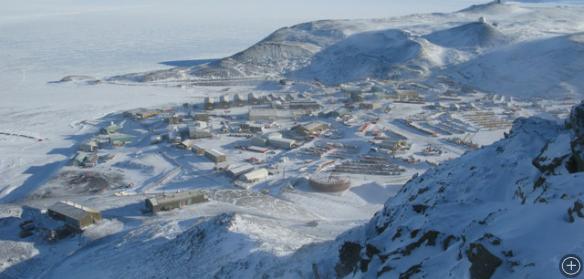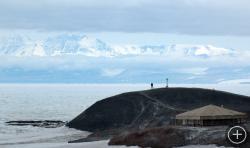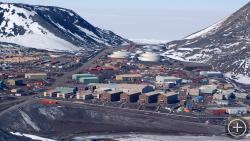McMurdo Station
Everyone is a visitor in Antarctica—no one lives there permanently—but there’s always a shifting crew of scientists around doing research. That’s because the continent, with its icy oceans, frigid temperatures, and unusual biology and geology, is like nowhere else on earth. For many scientists, their first (and sometimes only) stop is McMurdo Station, Antarctica’s largest research and logistical hub, run by the United States Antarctic Program (USAP).
Mac Town, as it’s informally known, sits solidly on volcanic rock at the southernmost point in Antarctica accessible by ship. Over a hundred years ago, British explorer Robert Scott built Discovery Hut close to the spot where Mac Town now stands (the hut and much of its original contents are still there). Later, in the fifties, McMurdo was a Naval Air Force facility. It wasn’t until the International 1957–58 Geophysical Year, a cooperative earth science research effort, that McMurdo became what it is today: a hub of scientific activity, sustained by a large crew of support staff including mechanics, cooks, computer technicians, and more. The support crew is crucial; it keeps the station running smoothly and the visitors safe.
With a transient population of more than 1,000 people in summer (about 250 in winter) and about a hundred buildings, McMurdo Station offers many of the amenities you’d expect to find in any big town. There’s a post office, coffeehouse, radio and TV stations, gym, barbershop, stores, three bars, power and water distillation plants, and more. Most supplies are shipped and flown in during the summer. A hydroponic greenhouse supplies the station with some locally grown vegetables, but otherwise fresh food is rare.
While life at McMurdo is much safer than it was for early Antarctic explorers, it’s still a perilous place. When visitors arrive in Mac Town, they have to take a full-day safety class before they can step off solid ground onto the sea ice. Besides the obvious dangers—severe weather or unseen crevasses in the ice—there are less obvious ones. Fire and a scarcity of water are ever-present threats.

Scientists build a snow shelter as part of their mandatory safety training known as Happy Camper School.
McMurdo relies on distilled seawater for its water supply; it has the only large-production saltwater distillation plant on the continent. But sometimes, particularly in summer, mechanical or other problems curb production, and supply can’t keep up with demand. Water conservation is a constant in Mac Town. With water in tight supply, a fire can be extremely dangerous. (You’d think snow would solve the problem, but using snow blowers to fight fires doesn’t seem to work: The snow is too powdery and easily blown off course.)
Though Antarctica is a huge outdoor laboratory that attracts a slew of scientists, it also draws people in the arts. The National Science Foundation, which supports much of the scientific research, has an Antarctic Artists and Writers program; it brought science fiction writer Kim Stanley Robinson and musician Henry Kaiser, for example, to the McMurdo area. The program’s goal: to increase people’s understanding of the continent, and to record America’s Antarctic legacy.













